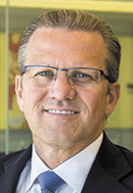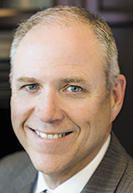Subscriber Benefit
As a subscriber you can listen to articles at work, in the car, or while you work out. Subscribe Now No one viewed Cincinnati-based First Financial Bancorp’s $1 billion acquisition of Greensburg-based MainSource Financial Group, announced this summer, as a merger of equals. After all, First Financial is nearly double the size of the bank it’s gobbling up.
No one viewed Cincinnati-based First Financial Bancorp’s $1 billion acquisition of Greensburg-based MainSource Financial Group, announced this summer, as a merger of equals. After all, First Financial is nearly double the size of the bank it’s gobbling up.
 Davis
DavisAnd that’s what makes the way the banks are integrating all the more extraordinary. When the deal closes in the first quarter, First Financial CEO Claude Davis will step into the role of executive chairman, and MainSource CEO Archie Brown will take Davis’ old job.
Similarly, First Financial Chief Financial Officer John Gavigan is giving up that role and becoming chief administrative officer, clearing the way for MainSource CFO Jamie Anderson to step into his shoes.
Also joining the executive team at First Financial are MainSource Executive Vice President Chris Harrison and Corporate Counsel Karen Woods, a former partner representing financial institutions at Krieg DeVault in Indianapolis.
 Brown
BrownAll of this is unusual in the banking realm, where egos often get in the way of such power sharing, said Mike Renninger, a principal with banking specialist Renninger & Associates in Carmel.
“The thing that is striking about this is the amicability with which this was negotiated,” Renninger said. “No doubt, it was the personal relationships that formed first at the CEO level, then the board and senior management levels, that created a level of trust that made this possible.”
While Renninger called Davis “magnanimous” for giving up the CEO’s job and agreeing to retire in three years, at which point he will be only 60, Davis said it only made sense to capitalize on the top talent from both banks.
“We really have approached this from a merger perspective in the truest sense of the word, and that is how we both get the most out of it,” Davis said.
That amicability is documented in a recent filing with the Securities and Exchange Commission, which provides a blow-by-blow account of the discussions leading up to the July 25 merger announcement.
MainSource agreed to the all-stock deal—which gave its shareholders a 15 percent premium to where their shares traded a day before the announcement—without going through the rigmarole of soliciting offers from other institutions or haggling endlessly over the price.
MainSource’s Brown said soliciting other offers wasn’t necessary because the banks and their advisers were aware of potential acquirers and ran financial models on what they might be able to afford to pay.
Furthermore, Renninger said, “For MainSource to shop itself to the highest bidder would probably have hurt the trust and relationships that were being built with First Financial.”
He called the $1 billion price “in the range of fair, absolutely. But what I think is even more important is what the upside opportunities are because of the economies of scale and market power the combined entity will have.”
Overlapping footprint
First Financial has $8.7 billion in assets and 102 offices in Indiana, Ohio and Kentucky. MainSource, meanwhile, has $4.6 billion in assets and 94 branches in Indiana, Illinois, Ohio and Kentucky. The institutions say the significant overlap will pave the way for $43 million in annual cost savings, in part by closing 45 to 50 branches.
The banks are betting they can close many of those branches without inconveniencing customers. That’s possible because 35 percent of First Financial deposits are within five miles of a MainSource branch, the SEC filing said.
The banks plan to accommodate the closings without laying off branch workers—instead assigning them to fill vacancies at other locations.
There will be a hit at MainSource’s Greensbug headquarters, which has more than 270 workers. As part of the merger, the banks are committing to keep employment in MainSource’s home county of Decatur above 100 and to invest $1 million in the community over five years, about 20 percent more than MainSource otherwise would have.
Boosting Indy presence
Once the deal closes, First Financial will have 16 branches in the Indianapolis market, double its current presence. It will rank sixth in deposit market share for all of Indiana and fourth in the Cincinnati market, according to an investor presentation the two institutions distributed this summer.
The SEC filing dates the start of the merger discussions to Feb. 28, when Davis and Brown met for lunch, as they had done once or twice a year for several years. At the meeting, “it became clear” the two men had “complementary views and strategies on many” banking issues, and they concluded it would be prudent to begin evaluating whether merging made sense, the filing said.
While both banks were strong performers, they faced significant challenges that merging would help remedy. For First Financial, the issue was that it soon would surpass $10 billion in assets, a threshold at which significant additional regulatory burdens kick in, including a cap on debit-card-swipe fees. Greater scale and efficiencies would help offset those costs.
Meanwhile, “one of the most significant challenges facing MainSource during the past several years has been the predominantly rural nature of its franchise,” the SEC filing said. “Specifically, MainSource’s branches have historically been located in small, non-metropolitan markets. Their markets were characterized by slower growth and presented few opportunities for economies through consolidation.”
Since 2009, MainSource has been trying to combat that by opening branches and pursuing acquisitions in Cincinnati, Louisville and Indianapolis, but it’s been slow going, in part because of a scarcity of acquisition targets, especially in Indianapolis.
“In Indy, we were going to have to build almost completely from scratch,” lamented Brown, 57.
A new branch typically has operating costs of about $400,000 and takes three years to break even. Even then, Brown said, it might not have a big impact on market share.
“It’s just a slog, a real slog, to get through that,” he said.
He added: “We thought there was probably a better way, as Claude and I started talking.”•
Please enable JavaScript to view this content.
